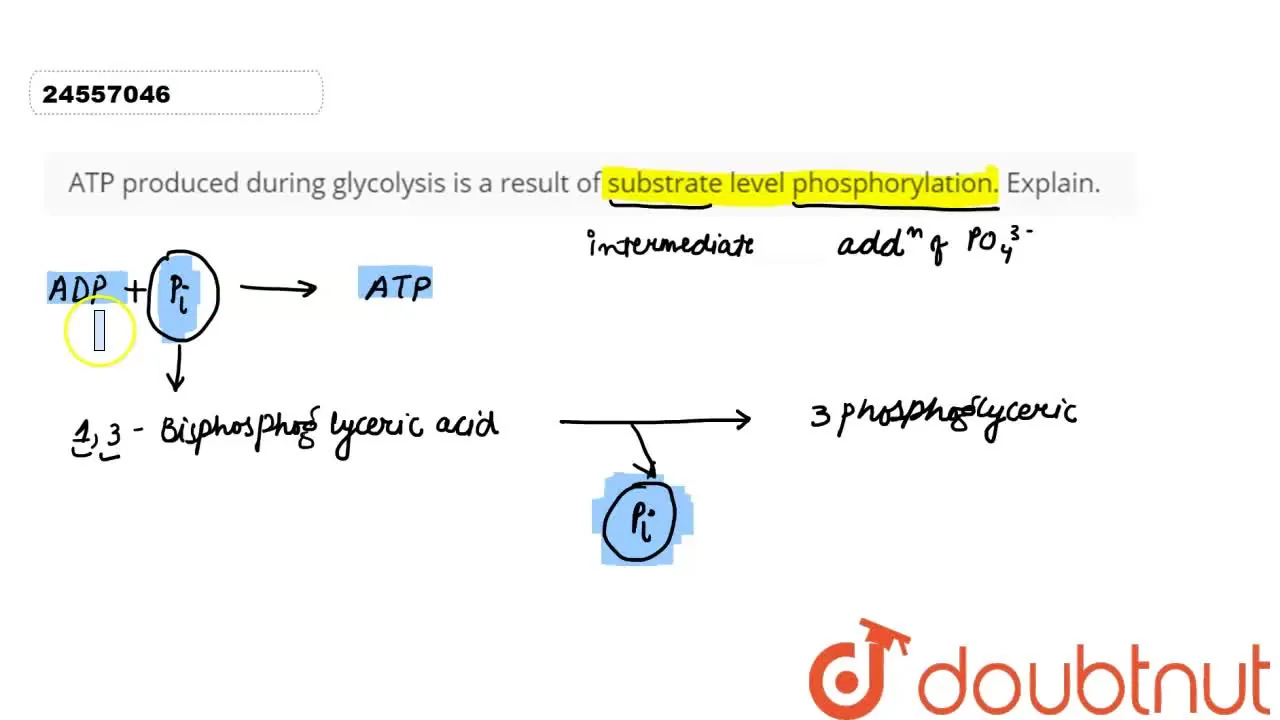ATP produced during glycolysis is a result of substrate level phosphorylation. Explain.
Video Solution
Text Solution
Substrate-level phosphorylation is a type of metabolic reaction that results in the formation of Adenosine Triphosphate (ATP) of Guanosine Triphosphat (GTP) by the direct transfer and donation of a phosphoryl (PO3) group to Adenosine Diphosphate (ADP) of Guanosine Diposphate (GDP) from a phosphorylated reactive intermediate.

In glycolysis substrate level phosphorylation occurs in following two reactions
(i) 2molecules of 3-phosphoglyceric acid react with 2 molecules of ADP to from 2 molecules of 3-phosphoglyceric acid and 2 molecules of ATP.
1,3−diphosphoglyceric2 mol eculesacid+2ADPphosphotransferase−−−−−−−−−−→Mg2+2−phosphoglyceric2mol eculesac+2ATP
(ii) 2 mol ecules of phosphoenolpyruvic acid reacts with 2 mol ecules of ADP to from 2 mol ecules of pyruvic acid and 2ATP.
1−phosphoenolpyruvic acid2mol ecules2ADPPyruvic kinase−−−−−−−−→Mg2+Pyruvic acid2mol ecuels+2ATP
|
Updated on:21/07/2023
Related Playlists
- BOOK - NCERT EXEMPLARCHAPTER - RESPIRATION IN PLANTS EXERCISE - LONG ANSWER TYPE QUESTIONS5videos
RESPIRATION IN PLANTS
- BOOK - NCERT EXEMPLARCHAPTER - RESPIRATION IN PLANTS EXERCISE - VERY SHORT ANSWER TYPE QUESTIONS7videos
RESPIRATION IN PLANTS
- BOOK - NCERT EXEMPLARCHAPTER - PLANT KINGDOMEXERCISE - LONG ANSWER TYPE QUSTIONS5videos
PLANT KINGDOM
- BOOK - NCERT EXEMPLARCHAPTER - STRUCTURAL ORGANISATION IN ANIMALSEXERCISE - long answer type questions5videos
STRUCTURAL ORGANISATION IN ANIMALS
Similar Questions
ATP is produced during
View SolutionWhat is substrate-level phosphorylation ?
View SolutionSubstrate level phosphorylation occurs during
View SolutionFrom substrate level phosphorylation ATP are produced
View SolutionA : Four ATP molecules are produced directly during glycolysis.
R : Substrate level phosphorylation occurs at two steps for a glucose broken down in mitochondrial matrix.View SolutionWhich of the following conversions in glycolysis is an example of substrate level phosphorylation?
View SolutionHow many substrate level phosphorylation take place in glycolysis
View SolutionSubstrate phosphorylation occurs during
View SolutionSubstrate for glycolysis is
View SolutionThe number of substrate level phosphorylation reaction in glycolysis is
View Solution


